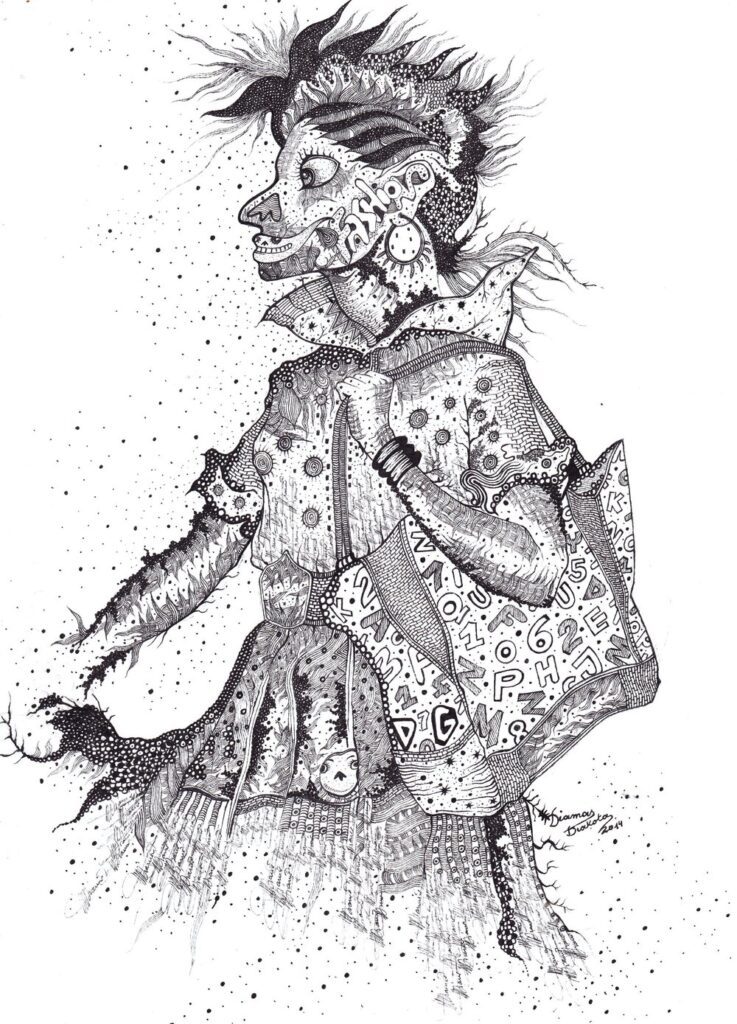In the Spotlight – Serge Diakota Mabilama by Horcelie Sinda Wa Mbongo.
Many of us anticipated the year 2020, especially in the art world, open up more discussions and spread the visibility of African artists globally. However, in the Congolese diaspora in the UK and internationally, few are exposed to art produced and led by Congolese natives even though there are emerging artists that have participated in exhibitions outside the country. Serge Diakota Mabilama is amongst many who are contributing to the discussion on Congolese art and pushing his art outside the borders.
Diakota started his career as a student in Kinshasa. Coming from a family of academics, he at first sought to study medicine and become a doctor. His teacher, a former student of the Academie de Beaux Art de Kinshasa, encouraged him to pursue a career in the arts. Taking this advice, Diakota pursued a career in Interior Design in 2006 in Kinshasa. This initial step in his artistic career evidently influenced his style which often exhibits his architectural skills.
Diakota’s practice took a more interdisciplinary turn when he came across the book Antiphilosophy, which discusses Marcel Duchamp’s ready-mades and “anti-art” approach. Diakota does not have any “borders” with the medium he chooses- this is demonstrated as an intrinsic part of his vision as an artist.

His choice of mediums includes domestic objects, such as chairs and mirrors, combined with paintings. According to the artist, domestic objects embody hidden messages, memories, realities, as well as the social-economical aspect of an individual. Diakota collects findings on individuals as a way of creating a “universal identity”. One may question the concept of universal identity in current times. However, according to the artist, creating a universal identity breaks the psychological borders countries may have with one another. Through his work, he hopes to dismantle the notion of hierarchy between nations. Within the visuality of art is an answer to equality. Diakota’s creation demonstrates a world without superiority, which he refers to as Anatomy: “The body needs the eye in order to form integrity”.

Fashion Model (2014), a drawing of ink on paper, as indicated in the title, takes inspiration from fashion. Diakota’s subjects appear “strange” and “bizarre” in this series of ink drawings, as as it is the unconventional/ abnormal subject that appeals to him. The odd drawings are fabricated and disfigure the human form.
Politics is a recurrent theme in the artist’s practice. In Eloge du Pouvoir (2019), Diakota reflects on the history of Congo, from The Congo Free State to the now Democratic Republic of Congo. The series of work was created as part of the Young Congo Biennale’s “Transition” exhibition, which highlighted the works of 40 artists from Congo working with various mediums. Transition sought to engage artists to rethink the political state of the country, from its leaders to its culture. The exhibition introduced a visual dialogue between artists and participants to confront past atrocities with urban realities.
As a response to the theme, Diakota’s Eloge du Pouvoir invites one to reflect on the legacy of different political leaders and its impact on the current state of the country. The artwork includes chronological paintings of all the Congolese presidents from 1965 to present, to clarify their leadership and influence.
Diakota has taken part in multiple international exhibitions such as ART Omi in New York, Montresso’s 3rd edition of In-Discipline in Marrakech, and 50/60 Milobela Festival in Strasbourg. Most recently, Diakota has participated in Art off-Screen, an international exhibition of artworks and performances in outward-facing locations around the globe. His most recent show, Home Not Alone – took place in Kinshasa at Kin ArtStudio. The artist is currently working on a series titled ‘Dreams and Cohabitation’, which aims to explore themes of migration and the status of refugees. As the title suggests, Diakota’s dream is to propose a new way of cohabitation.






 No products in the basket.
No products in the basket.